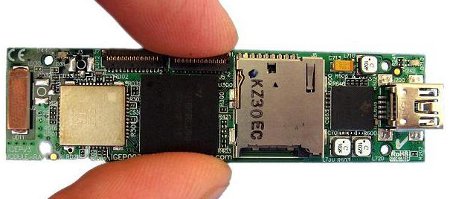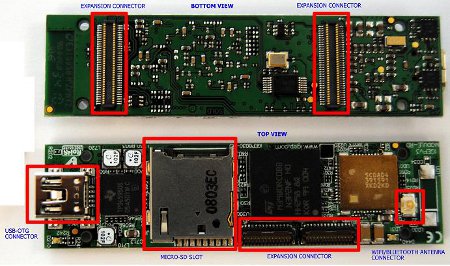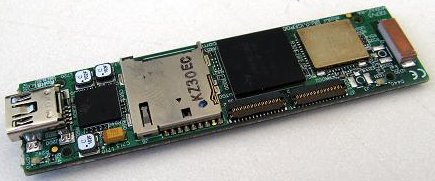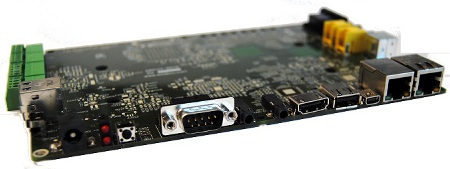Tiny, wireless-ready module offers choice of Cortex-A8 SoCs
Nov 11, 2010 — by Eric Brown — from the LinuxDevices Archive — 8 views[Updated: Nov. 12] — ISEE began shipping a computer-on-module (COM) that offers extended-temperature support and a choice of TI Cortex-A8 SoCs: the OMAP35xx or the newer 1GHz DM37xx. The Linux-ready, 2.68 x 0.71-inch IGEP Module features built-in 802.11b/g and Bluetooth 2.0, as well as an onboard microSD slot and USB On-The-Go port that enable the module to act as a standalone computer.
Headquartered near Barcelona, Spain, ISEE introduced its first IGEP single board computer (SBC) on an ARM9 processor, back in 2007. The company launched its first Cortex-A8 version, called the IGEPv2 using the Texas Instruments (TI) OMAP35xx in 2009. The new IGEP Module version also supports the OMAP35xx, but adds support for TI's recently introduced, 720p-ready DaVinci DM37xx system-on-chip (SoC).

IGEP Module
(Click to enlarge)
The new IGEP Module is available with a Linux board support package (BSP) that includes a GNU-Linux kernel, an SDK, and precompiled software available on git repositories, says ISEE. In addition, the module is said to be compatible with other operating systems that support TI's ARM Cortex-A8 processors, including Windows Embedded CE.

IGEP Module detail
(Click to enlarge)
The IGEP Module measures only 2.68 x 0.71 inches (68 x 18mm), slightly larger than Gumstix' OMAP35xx-based Overo module, which measures 2.3 x 0.7 inches. In addition, the IGEP Module supports operating temperatures ranging from -40 to 185 deg. F (-40 to 85 deg. C), says the company.
As a result, the module can meet the needs of a variety of space- and power-constrained commercial and industrial embedded applications that require high-quality graphics and/or video, says ISEE. Applications are said to include portable data terminals, navigation devices, auto infotainment, gaming, medical imaging, home automation, HMI, industrial control, and test and measurement.
Double duty as SBC
Unlike many COMs, the IGEP Module can be used as an SBC, as well as being pluggable into a baseboard such as ISEE's optional IGEP Module Expansion Board (see farther below).
Equipped with a USB 2.0 On-The-Go miniAB socket, the module can use an Ethernet-over-USB gadget for communications, says ISEE. The USB peripheral will "enumerate to the host as an Ethernet device, using the usbnet driver with Linux hosts or Microsoft's RNDIS driver with Windows hosts," says ISEE.
Users can then set up the module as they would with any other Ethernet link, says the company. The onboard microSD slot also helps enable standalone performance for applications that require a minimal footprint, ISEE adds.
Most of the device's I/O is communicated to a baseboard via a 2×70 pin PCB-to-PCB connector on the bottom of the module. In addition, a 2×27 pin flex ribbon cable connector on the top of the IGEP Module can be used as a camera interface, as well as an interface for "other peripherals," says the company.
The IGEP Module comes in two standard memory configurations, one with 128MB RAM and 256MB of flash storage, and the other with 512MB RAM and 512MB of flash, says ISEE. (Custom configurations with 1GB or 2GB of RAM and 2GB or 4GB of flash are also available, but most are said to require a minimum order of at least 100 units.) The module offers built-in 802.11b/g Wi-Fi and Bluetooth 2.0 wireless communications, says the company.
In addition to the standard onboard microSD slot and USB 2.0 OTG miniAB socket cited above, the module offers an onboard USB 2.0 Host interface, says ISEE. Other I/O is made available over the two pin connectors. Interfaces are said to include I2C, SPI, UART, audio connections, and more (see spec list farther below).
A choice of TI Cortex-A8 SoCs
The standard OMAP3530 SoC available with the module is the top-of-the line version used in the BeagleBoard. Its 720MHz Cortex-A8 core is matched with a C64x+ DSP core for video acceleration and a POWERVR SGX 2D/3D graphics accelerator. (The also-listed OMAP3503 lacks either of these enhancements. )

Another view of the IGEP Module
The DM3730 is also equipped with a 800MHz C64x+ DSP core (faster than the OMAP3530's), and a 3D graphics accelerator. I/O, however, is very similar to that of the OMAP3530.
Other custom configurations are also possible, says the company. ISEE doesn't get specific, but these might possibly include the OMAP3525 (DSP only), the OMAP3515 (3D accelerator only), or, moving up to the DaVinci line, the DM3725 (DSP only). It is unclear whether a Wi-Fi and Bluetooth version is available for the DM3730, as well.
Features and specifications listed for the IGEP Module module include:
- Processor — TI OMAP3530 (720MHz) or DaVinci DM37xx (800MHz), both Cortex-A8; other options available include OMAP3503
- Memory — 128MB or 512MB RAM, and 256MB or 512MB of flash, plus custom versions with up to 4GB RAM and 4GB of flash
- Flash expansion — microSD slot
- Wireless — 802.11 b/g; Bluetooth 2.0
- Onboard USB 2.0:
- OTG miniAB socket for power and data
- USB 2.0 Host interface
- Other I/O (via 2×70-pin and 2×27-pin connectors):
- I2C
- 6 x PWM lines
- 6 x A/D
- 1-wire
- UART
- SPI
- camera in
- extra MMC lines
- headset
- microphone
- backup battery
- Dimensions — 2.68 x 0.71 inches (68 x 18mm)
- Operating temperature — -40 to 185 deg. F (-40 to 85 deg. C)
- Operating system — Linux BSP; also supports other OSes including RTOSes and Windows Embedded CE

|
IGEP Module Expansion Board
(Click to enlarge)
- socket for IGEP Module
- LCD and touch interface for 7-inch Seiko LCD
- LCD and touch interface for 4.3-inch Sharp LCD
- VGA interface on D-SUB15 connector
- video composite inputs on RCA connector (2 x optional); video decoder based on TI TVP51510
- 4 x USB Host 2.0 ports and 1 x USB OTG 2.0 miniAB
- 2 x gigabit Ethernet ports
- DVI and HDMI ports (both under evaluation)
- audio I/O
- GSM/GPRS modem based on TELIT GE865 module with SIMCARD connector, external cable, and antenna
- CAN bus interface with 4 pin connector (Microchip MCP2515 CAN controller)
- serial port on DB9 connector
Availability
The IGEP Module is available for 172 euros ($235) for an evaluation model based on a 720MHz OMAP3530 SoC, 512MB DDR2 RAM, 512MB of flash storage, Wi-Fi, and Bluetooth.
The module and other ISEE products are available at its English-ready online store, here.
More on the IGEPv2 module may be found here. More on the expansion board may be found here.
This article was originally published on LinuxDevices.com and has been donated to the open source community by QuinStreet Inc. Please visit LinuxToday.com for up-to-date news and articles about Linux and open source.